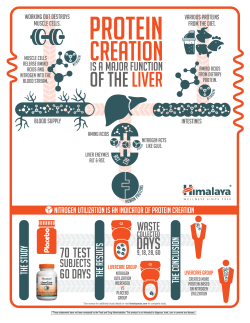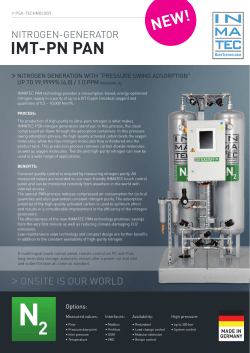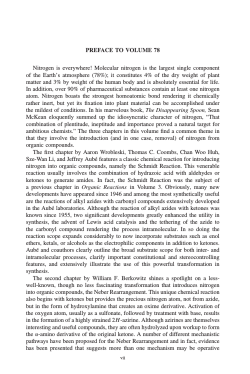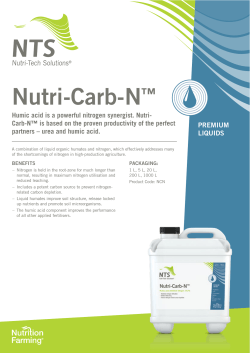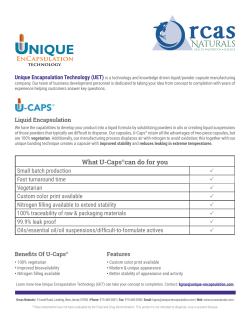
the start-up of the anammox process in the membrane
THE START-UP OF THE ANAMMOX PROCESS IN THE MEMBRANE-ASSISTED BIOREACTOR J. Surmacz-Górska, S. Żabczyński and K. Miksch Department of Environmental Biotechnology, Silesian University of Technology, Akademicka 2, 44 100 Gliwice, Poland ABSTRACT The experiments carried out proved possibility for implementation of deamonification process in membrane-assisted bioreactor. At the temperature above 30°C, dissolved oxygen concentration below 0.8 mg O2/L and at the very low contents of biodegradable organic compounds within 1 month of process operation stable nitrite and ammonia nitrogen concentrations were reached at the levels respectively of 130 mg NO2- - N/L and around 60 mg NH4+ - N/L. At the same time nitrates were not produced in the significant amounts. This allowed to reach total nitrogen removal over 50%. Introduced deamonnification process resulted also in increased pH level in the reactor in comparison to pH noted at the nitrification process in the MBRN what agrees with theories about chemical pathways of Anammox process. KEYWORDS Anammox process, nitrification, membrane-assisted bioreactor, nitrogen removal INTRODUCTION Processes of micro – and ultrafiltration become more and more popular in environmental engineering. The use of membrane instead of the secondary clarifier in the processes of the wastewater treatment generates a lot of advantages, for example high efficiency of selectivity, which effect in good quality of the effluent, retention of all the biomass, which effects in facilitating of the sludge retention time (SRT) control, reliability of the unit operation, easily enhancement of the unit scale, because of module construction and the compact dimensions of the whole system. Apart from mentioned advantages in membrane assisted bioreactor (MBR) excess sludge production is lower than in conventional activated sludge systems (Ghyoot et al., 2000, Rols et al., 1997), what becomes important on account of the cost connected with treatment of the sludge. COD removal achieves high level and the nitrification of the ammonia nitrogen concentration typical for municipal wastewater usually is complete (Rosenberger et al., 2002, Cicek et al., 2001, Nagaoka et al., 1999). Also progress in wastewater treatment processes take place. The Anammox process is a new system, which was discovered by scientists and held attention for last years. This process allows to reduce aeration and eliminate necessity of external carbon source addition to the system. Moreover, use of Anammox process to eliminate total nitrogen from the wastewater causes reduction of reactor’s volume in comparison with conventional nitrification – denitrification process. The Anammox process is autotrophic process, therefore a complete conversion of ammonia nitrogen to 67 Surmacz-Górska, Żabczyński and Miksch, The start-up of the Anammox process in the membrane…… nitrogen gas can take place without any addition of organic carbon. The overall reaction of the Anammox proposed by Siegriest is as follows: NH4+ + O2 ® 0,5 N20 + 1,5 H20 + H+ NH4+ + O2 ® 0,33 N2 + 0,33 NO2- + 1,33 H20 + 1,33 H+ The Anammox process are characterized by high capacity (2,6 kg N/m3 d), therefore it can be used for design compact system for wastewater treatment (van Dongen, 2001). By the combining membrane process and Anammox process a new, high efficient system can be created to facilitate high ammonia wastewater treatment. MATERIAL AND METHODS For purpose of this research two reactors of the 25 L were started up: MBRN - membrane assisted bioreactor with full nitrification and MBRA – membrane assisted bioreactor with Anammox process (fig. 1). They were fed by synthetic wastewater. For membrane reactor (MBRN) the feed contained 2 g NH4Cl/L, 6,3 NaHCO3/L, 0,12 g K2HPO4/L, 0,25 g of broth/L and 0,38 g CH3COONa/L, for Anammox reactor (MBRA) the feed was composed as follows: 2 g NH4Cl/L, 6,8 NaHCO3/L, 0,12 g K2HPO4/L, 0,1 g of broth/L. The feed was dosing by the peristaltic pump and in the same way the permeate was sucked up. Excess biomass was withdrawn from the MBRN on the daily basis, as to maintain 10 days sludge age. In order to introduce the Anammox process in the MBRA the temperature was progressively increased. influent effluent influent effluent heating immersion 1 flat sheet membrane flat sheet membrane bioreactor bioreactor aeration 2 aeration Figure 1. Scheme of the investigated reactors: 1 – MBRA, 2 - MBRN. In both reactors VA TECH WABAG flat sheet membranes were used. Pore size was 0,4 mm and the total surface area was equal to 0,116 m2. 68 Surmacz-Górska, Żabczyński and Miksch, The start-up of the Anammox process in the membrane…… The operation conditions are given in table 1. Table 1. Operation conditions of the MBRN and MBRA MBRN Parameter Unit MBRA VALUE Reactor volume Flow rate Hydraulic retention time (HRT) COD0 before 86 day COD0 after 86 day NH4+ - N0 before 86 day NH4+ - N0 after 86 day Sludge organic loading rate before 86 day Sludge organic loading rate after 86 day Sludge NH4+-N loading rate before 86 day Sludge NH4+-N loading rate after 86 day Biomass concentration before 86 day Biomass concentration after 86 day L L/d d 25 9 2,8 25 7,5 3,3 mgO2/L mgO2/L mg/L mg/L g COD/g MLSS d g COD/g MLSS d g NH4+-N/g MLSS d g NH4+-N/g MLSS d g MLSS/L 366 - 616 245 - 466 151 – 586 461 – 530 0,135 – 0,465 366 - 616 27 – 193 151 – 586 465 - 545 0,034 – 0,114 0,037 – 0,112 0,003 – 0,026 0,140 – 0,510 0,042 – 0,124 0,072 – 0,144 0,047 – 0,084 0,4 – 1,2 0,2 – 2,4 g MLSS/L 1,3 – 2,4 1,4 – 2,6 During the research period the samples were taken from influent, effluent and mixed liquor at least three times a week. The pH was measured by portable WTW pH-meter, dissolved oxygen and temperature by portable WTW DO-meter, biomass concentration, COD was measured by dichromate method, Kjeldahl nitrogen and ammonia nitrogen were determined by means of Kjeltec System 1026 Tecator, nitrite and nitrate nitrogen were determined colorimetrically and respiratory activity of the first and the second stage of the nitrification were measured as described in (Surmacz-Górska et al., 1996). RESULTS AND DISCUSSION In order to introduce nitrification process in the MBRN and nitritation process in the MBRA during first 86 days both reactors were fed with the same influent characterised by average COD amounted to 486 mg/L, average NH4+-N concentration equal to 495 mg/L and pH corrected to 8.5. In both reactors high ammonia nitrogen removal was observed from the very beginning of the experiments reaching respectively 81% and 90% in the MBRN and the MBRA (Fig. 2 and 3). At the same time nitrite nitrogen was the main product of ammonia oxidation in this period of experiments. In both cases its concentration exceeded 300 mg NO2-- N/L (Fig. 4 and 5). After 30 days of the experiment in the MBRN gradual increase of nitrate nitrogen was observed and since 78th day nitrate nitrogen was the main product of nitrification process exceeding nitrite nitrogen concentration (Fig. 4). In the MBRA nitrate nitrogen was kept at the low level around 10 mg NO3- - N/L (Fig. 5). In both reactors nitrogen removal was observed reaching 15% and 27% in the MBRN and the MBRA respectively what was mainly the result of bacteria growth. 69 700 120 600 100 500 80 400 60 300 40 200 20 100 84 78 50 38 31 24 92 11 5 12 5 12 9 13 4 13 9 14 3 14 8 15 3 16 0 0 6 13 17 1 0 ammonia nitrogen removal, % mgNH 4 + -N/L Surmacz-Górska, Żabczyński and Miksch, The start-up of the Anammox process in the membrane…… tim e, d ays ammonia nitrogen influent ammonia nitrogen effluent ammonia nitrogen removal 700 120 600 100 500 80 400 60 300 40 200 20 100 92 11 5 12 5 12 9 13 4 13 9 14 3 14 8 15 3 16 0 84 78 50 38 31 0 6 13 17 1 0 ammonia nitrogen removal, % mgNH 4 + -N/L Figure 2. Ammonia nitrogen removal in the MBRN. tim e, d ays ammonia nitrogen influent ammonia nitrogen effluent Figure 3. Ammonia nitrogen removal in the MBRA. 70 ammonia nitrogen removal 700 60 600 50 mgN/L 500 40 400 30 300 20 200 10 100 11 3 12 2 12 7 13 4 13 9 14 3 14 8 15 3 16 0 84 78 43 31 22 0 13 6 0 nitrogen removal, % Surmacz-Górska, Żabczyński and Miksch, The start-up of the Anammox process in the membrane…… tim e, d ays ammonia nitrogen influent nitrate nitrogen effluent nitrogen removal ammonia nitrogen effluent nitrite nitrogen effluent Figure 4. Nitrification performance in the MBRN. 700 80 T COD¯ DO¯ 70 600 mgN/L 50 400 40 300 30 200 20 100 10 11 3 12 2 12 7 13 4 13 9 14 3 14 8 15 3 16 0 84 78 43 31 22 0 13 0 6 nitrogen removal, % 60 500 tim e, d ays ammonia nitrogen influent nitrate nitrogen effluent nitrogen removal ammonia nitrogen effluent nitrite nitrogen effluent Figure 5. Anammox process start-up in the MBRA. As the first stage of nitrification was established in both reactors with high concentration of nitrite nitrogen in the MBRA technological parameters have been changed in order to introduce Anammox process. Since 80th day of the experiment dissolved oxygen concentration in the MBRA was decreased to the level 0.5 – 0.7 mg O2/L, next since 86th day average COD was lowered to 67 mg O2/L and since 129th day the temperature in the MBRA was increased above 30°C (Fig. 5). At the same time in the MBRN any changes were introduced. In the MBRN the improvement of nitrification was observed. Stable ammonia nitrogen removal reaching in average 98% was accompanied by very low ammonia and nitrite nitrogen 71 Surmacz-Górska, Żabczyński and Miksch, The start-up of the Anammox process in the membrane…… concentrations in effluent. Almost all ammonia nitrogen was oxidised to nitrate nitrogen, which concentration in effluent levelled at around 450 mg NO3- - N/L. Total nitrogen removal in the MBRN was low and oscillated around 9% in average (Fig. 2 and 4). The biocenosis of the MBRA gave very quick answer for the introduced changes. The decrease of dissolved oxygen concentration in the reactor and biodegradable organic carbon in influent resulted in the slight drop of nitrites concentration but neither ammonia nor nitrates increase was observed in effluent in the same time (Fig. 5). However the most significant effects were observed after the increase of temperature in the reactor. The concentration of nitrite nitrogen dropped drastically below the level of 150 mg NO2- - N/L, nitrate nitrogen was still kept at the low level but the ammonia nitrogen increased slightly in effluent not exceeding the concentration of 100 mg NH4+ N/L. As a result total nitrogen was removed in the MBRA since that moment in more than 50 % (Fig. 4). The average level of total nitrogen removal from 86th day till the end of experiments was 49%. The carried out experiments proved that deamonification process can be implemented in membrane – assisted reactor and on the other hand confirmed that temparature, anoxic conditions and lack of biodegradable organic compounds are significant parameters for enhancement of deamonification process (Hippen et al., 1997; Siegrist et al., 1998; van Dongen et al., 2001). The microorganisms growth rate in the MBRN and the MBRA was different. In the MBRN 10-daysludge age was maintained and within 5 months very slow and stable increase of biomass concentration from 1 to 2.2-2.4 g MLSS/L was noted (Fig. 6). In the MBRA at the beginning of experiments within first 86 days the biomass grew quicker than in the MBRN because excess of biomass was not withdrawn in order to achieve long sludge age needed for Anammox bacteria growth. It resulted in 86th day in doubled biomass concentration in the MBRA in comparison with the MBRN (Fig. 6). Lowered dissolved oxygen concentration in the MBRA and COD in influent since 86th day resulted first in drastic biomass concentration decrease from 2.4 to 1.4 g MLSS/L but after a few days when the temperature increased very slow increase in biomass concentration started to be observed again (Fig. 6). The increase of biomass concentration in the MBRN and the MBRA were comparable after 86th day of experiments but taking into account fact that in the MBRN biomass was removed in amount of 1/10 per day it is visible that biomass in the MBRA grew much slower. It is obvious that lack of biodgradable organic carbon in the influent to the MBRA resulted in lack of heterotrophs growth and lower biomass concentration but on the other hand Anammox bacteria are known as much slower growing than nitrifiers (van Dongen, 2001). Therefore lower bacterial growth rate is a result probably of both phenomena – lack of heterotrophs and slow Anammox bacteria growth. 72 Surmacz-Górska, Żabczyński and Miksch, The start-up of the Anammox process in the membrane…… 3 2.5 MLSS,g/L 2 1.5 1 0.5 0 8 13 27 34 41 69 76 83 89 111 118 132 139 146 153 160 time, days MBRN MBRA Figure 6. Biomass concentration in the MBRN and the MBRA The pH values measured in the reactors reflected very well the character of occurring processes. In the influent to the both reactors pH value was corrected and maintained at the stable value of 8.5 (Fig. 7). In the beginning of experiments, when both reactors operated in the same way, pH in both reactors dropped to the values 7.5 and 6.5 respectively in the MBRN and in the MBRA because of dominating first stage of nitrification. In the MBRN pH value was stable and equal 7.5 till the end of experiment. However in the MBRA, when Anammox process was introduced, pH increased to 88.5. It agrees with theories that within Anammox process ions H+ produced at ammonia oxidation to nitrites are used in further reactions of nitrite reduction to gaseous forms (Schalk et al., 1998; Siegrist et al., 1998) what confirms that for observed process Anammox bacteria are responsible. 10 pH 9 8 7 92 11 5 12 5 12 9 13 4 13 9 14 3 14 8 15 3 16 0 16 7 80 73 43 31 24 17 13 8 3 6 tim e, d ays Influent MBRN Figure 7. pH variations in the MBRN and the MBRA 73 MBRA Surmacz-Górska, Żabczyński and Miksch, The start-up of the Anammox process in the membrane…… Interesting information about microorganisms activity gave OUR measurements. The activity of Nitrosomonas-like bacteria in both reactors was comparable at the beginning of experiments when the reactors operated in the same way (Fig. 8). Introduced Anammox process resulted in the increase of OUR by Nitrosomonas-like bacteria in the MBRA although the ammonia nitrogen concentration in the influent to the both reactors was the same. It can suggest two possibilities either these bacteria are more numerous in biocenosis and therefore their volume activity is higher or they are responsible for more reactions than only ammonia oxidation to nitrites and they participate also in Anammox process what results in the increased activity. In literature there are reported information about different metabolic possibilities of Nitrosomonas –like bacteria. For instance Nitrosomonas europea is capable to convert hydrazine to nitrogen gas (Schalk et al., 1998) as well as Nitrosomonas europea and Nitrosomonas eutropha are able to nitrify and denitrify (van Niel, 1993). Therefore this explanation can be taken into consideration. 120 OUR, mgO2/Lh 100 80 60 40 20 16 0 15 3 14 8 14 3 13 9 13 4 12 7 11 5 73 43 31 24 17 13 8 0 time, days MBRN MBRA Figure 8. OUR of Nitrosomonas-like bacteria in the MBRN and the MBRA Over three-time higher activity of Nitrobacter-like bacteria in the MBRA than in the MBRN is more difficult to explain (Fig. 9). Probably these bacteria are still present in the MBRA and during the test they started to consume oxygen or another group of bacteria have the same vulnerability to sodium chlorate and their activity was measured as the activity of Nitrobacter –like bacteria. In order to answer this question more detailed experiments have to be done. 74 Surmacz-Górska, Żabczyński and Miksch, The start-up of the Anammox process in the membrane…… 30 OUR, mgO2/Lh 25 20 15 10 5 16 0 15 3 14 8 14 3 13 9 13 4 12 7 11 5 73 43 31 24 17 13 8 0 time, days MBRN MBRA Figure 9. OUR of Nitrobacter-like bacteria in the MBRN and the MBRA CONCLUSIONS The experiments carried out proved that retention of biomass in membrane-assisted bioreactor and long sludge age give possibility for implementation of deamonification process. At the temperature above 30°C, dissolved oxygen concentration below 0.8 mg O2/L and at the very low contents of biodegradable organic compounds within 1 month of process operation stable nitrite and ammonia nitrogen concentrations were reached at the levels respectively of 130 mg NO2- - N/L and around 60 mg NH4+ - N/L. At the same time nitrates were not produced in the significant amounts. This allowed to reach total nitrogen removal over 50%. Introduced deamonnification process resulted also in increased pH level in the reactor in comparison to pH noted at the nitrification process in the MBRN what agrees with theories about chemical pathways of Anammox process. REFERENCES Cicek N., Macomber J., Davel J., Suidan M. T., Audic J., Genestet P. (2001). Effect of solids retention time on the performance and biological characteristics of a membrane bioreactor. Wat. Sci. and Tech., 43 (11), 43 – 50. Ghyoot W., Verstraete W. (2000). Reduced sludge production in a two – stage membrane assisted bioreactor. Wat. Res., 34 (1), 205 – 215. Hippen A. Rosenwinkel K. A., Baumgarten G., Seyfried C. F. (1997). Aerobic deammonification: a new experience in the treatment of wastewaters. Wat. Sci Tech., 35 (10), 111 - 120. Nagaoka H. (1999). Nitrogen removal by submerged membrane separation activated sludge process. Wat. Sci. and Tech, 39 (8), 107 – 114. Rols J. L., Goma G. (1997). Reduction of sludge production during biological wastewater treatment. International Symposium Environmental Biotechnology. Ostenda, 71 – 74. Rosenberger S., Krueger U., Witzig R., Manz W., Szewzyk U., Kraume M. (2002). Performance of a bioreactor with submerged membranes for aerobic treatment of municipal waste water. Wat. Res., 36, 413 – 420. 75 Surmacz-Górska, Żabczyński and Miksch, The start-up of the Anammox process in the membrane…… Schalk J., Oustad H., Gijs Kuenen J., Jetten M. S. M. (1998). The anaerobic oxidation of hydrazine: a novel reaction in microbial nitrogen metabolism. FEMS Microbiology Letters., 158, 61 – 67. Siegriest H., Reithaar S., Koch G., Lais P. (1998). Nitrogen loss in a nitryfying rotating contractor treating ammonium-rich wastewater without organic carbon. Wat. Sci. Tech., 38 (8-9), 241 – 248. Surmacz – Górska J., Gernaey K., Demuynck C., Vanrolleghem P., Verstreate W. (1996) Nitrification monitoring in activated sludge by oxygen uptake rate (OUR) measurements. Wat. Res., 30 (5), 1228 – 1236. Van Dongen L. G. J. M., Jetten M. S. M., van Loosdrecht M. C. M. (2001). The combined Sharon/Anammox Process. IWA publishing. Van Niel E. W. J. (1993). Nitrification by heterophic denitrifiers and its relationship to autotrophic nitrification. Ph. D. Thesis, Delft University of Technology, Department of Microbiology and Enzymology. 76
© Copyright 2025

